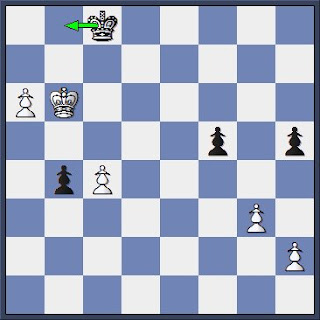This position occurred on 5th Board in the Conant match. White has an extra passed a-pawn, but all three of Black's pieces are well positioned to oppose its advance. The only piece supporting the pawn is the White rook, but since it is front of the pawn, it will have to move off the a-file in order for the pawn to reach the queening square at which point the pawn will be completely unprotected. Since the a-pawn is perfectly secure on its present square, White's first priority should be to get his king and knight involved in the game. Bringing the knight to c4 via e3 is one obvious plan.
The game eventually reached a king and pawn ending. The winning technique here is for White to get his king in front of his pawn with 57.Kg5 Kf7 58.Kh6 Kg8 59.Kg6 Kh8 60.g5 Kg8 61.Kh6 Kh8 62.g6 Kg8 63.g7 Kf7 64.Kh7 and the pawn queens. After 57.g5, which White played, Black should have been able to draw with 57...Kf7 58.Kh5 Kg7 59.g6 as long as he remembered that Straight Back Draws 59...Kg8 60.Kh6 Kh8 61.g7+ Kg8 62.Kg6 stalemate.
This endgame occurred on 6th Board against Conant. It should be a fairly easy win for Black. In an open position with pawns on both sides of the board, the rook is a much stronger piece than the knight. All Black needs to do is to find a square for the rook that maximizes its attacking capabilities. Any square on the 2nd rank would give the rook many targets. 26...Re1 is a logical way to start.
Unfortunately, Black chose to advance pawns instead. Rooks are much better at attacking than defending. Even after several pawn moves, Black still could have gone on the offensive with 32...Rd2.
In this final position, the Black pawn doesn't need any support, but Black still needs to improve his piece before pushing it. In the game, Black played 50...b3? and lost after 51.a7 b2 52.a8=Q+ Ke7 53.Qa2. Black could have won with 50...Kb8! 51.a7+ Ka8 52.c5 b3 53.c6 b2 57.c7 b1=Q+.





No comments:
Post a Comment